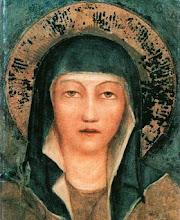Red-Carpet-Worthy Habits: The Poor Clares

Hence, over the next two weeks I’m going to be doing a series that focuses on the habits of various orders of nuns! Sisters, strike a pose!
First on the "red carpet" we have the Poor Clares. The Poor Clare Colettine habit has changed very little since St. Clare first donned it 800 years ago. The only major change is that the wimple (the cloth that goes around the neck) used to cover part of the chin. Also, in a conversation with Mother Clare from the Barhamsville Monastery, some Poor Clares still wear a mantle (a kind of cape) which serves the dual purpose of providing warmth and concealing the feminine figure. The Poor Clares in warmer climates don’t wear mantles, since the guimpe (the part of the habit that looks like a baby’s bib) serves the purpose of hiding the feminine form. I was once told by someone else that the reason why Poor Clares wear black veils is because St. Clare first went to live with the Benedictine Nuns before she officially started her own order of Poor Ladies. She decided to keep the black veil as a reminder of the close relationship between her own order and the Benedictine Nuns. St. Scholastica would be proud!
Here is an excerpt from the Poor Clare constitutions on their habits:
“These are the Poor Clare nuns. The habit is grey-brown in color. The simple white headdress is unstarched, the black veil plain. The white Franciscan cord has four symbolic knots, representing the religious vows
Even though their habit is slightly different, here is a lovely reflection on the Poor Clare habit worn by the Poor Clare Nuns of Perpetual Adoration, more commonly known as the EWTN Nuns:
The habit is an exterior sign of our commitment and total consecration to Jesus Christ. Each part of the holy habit, even its colors, has deep spiritual meaning.
Underneath the white veil, the nun wears a white head covering. This is a symbol that her mind is not on "the world" but on the Kingdom that is to come. No part of her mind, intellect, memory, or will is to be part of the world, part of darkness, or part of anything that is contrary to Jesus Christ. The white collar is a symbol that the nun is surrounded with "community", the religious life lived in common. She wishes to live in goodness, in love, and in poverty of mind and heart. She puts at the very top of her body, which is consecrated to God, something white as a constant reminder that she is a temple of the Holy Spirit. That temple must be ever clean and pure. All the white parts of her habit are a symbol of her desire to exemplify the awesome purity of God Himself in the Most Holy Eucharist.
The earthly color of the brown Franciscan habit reminds the nun of the Scripture passage used on Ash Wednesday: "Remember thou art dust and to dust thou shalt return". It also is a remembrance for her that - without Him - she is absolutely nothing.
The white Franciscan cord, with three knots in it, symbolizes the vows of poverty, chastity, and obedience that this new novice hopes to make at her first holy profession. Over the habit is placed a brown mantle, which is worn at the Holy Sacrifice of the Mass. It is a symbol of the nun's love for Our Lady and also of the Blessed Virgin Mary's maternal protection.









2 Comments:
That was very interesting. I recently found your blog -- I have to say I always learn something from it.
Hope you are having a blessed Lenten season!
Isn't it amazing how God raises someone up in every generation to reform His Church? Who will it be for this generation?
It is truly amazing to see the "Cells" of some of our Franciscan brothers and sisters. I can't remember who it was that after visiting several Franciscan houses commented upon their lavish luxury saying, "If this is living a vow of poverty, I can only imagine their vow of chastity!"
Post a Comment
<< Home